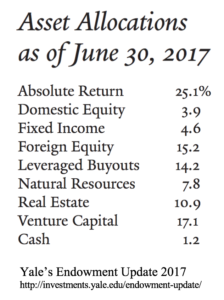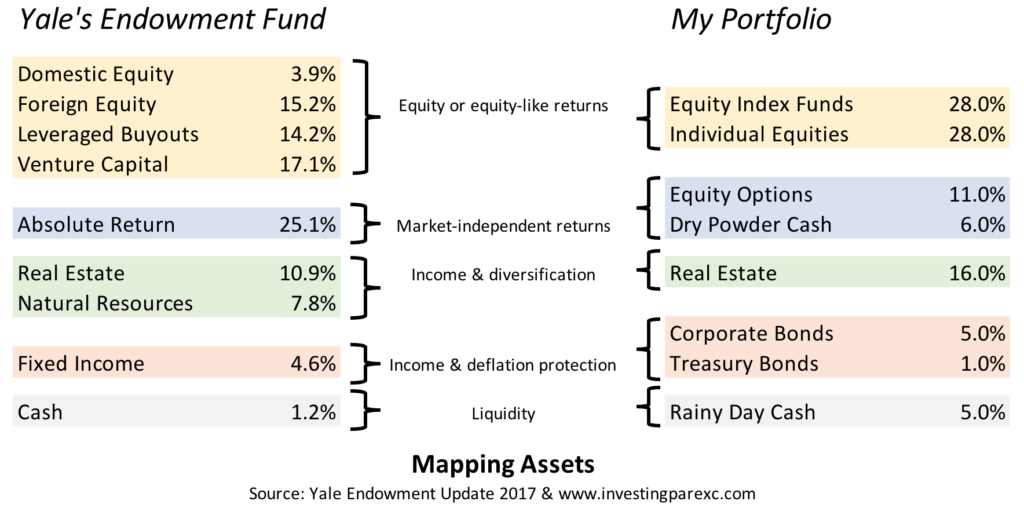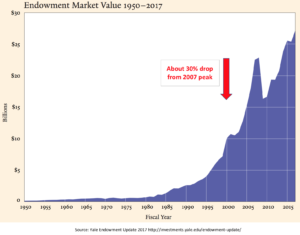 I realize that this sounds silly. Individual investors and university endowments don’t play in the same league! Still there is no harm in studying other investors’ portfolios. Even those that are managed professionally. For perspective, current market value of Yale University’s endowment fund is in eleven figures (about $27 billion) while my portfolio registers in seven figures. But there are always good insights to glean – even from a distinct heavy-weight like Yale.
I realize that this sounds silly. Individual investors and university endowments don’t play in the same league! Still there is no harm in studying other investors’ portfolios. Even those that are managed professionally. For perspective, current market value of Yale University’s endowment fund is in eleven figures (about $27 billion) while my portfolio registers in seven figures. But there are always good insights to glean – even from a distinct heavy-weight like Yale.
Why pick Yale and not any other endowment? Because Yale stands out among all other endowment funds for two reasons. One, it has the best twenty-year performance among all university endowments. And secondly, the fund’s CIO (Chief Investment Officer), David Swensen, is considered the best in the industry. His approach to endowment investing was one-of-a-kind when he pioneered it 33 years ago. Since then his so-called Yale’s Model has been very successful and today his approach is copied by many of his peers in the endowment world. His investing approach is distinct in two ways. He focuses on more asset classes than his peers – and he pioneered extensive use of alternative investments.
I’ve also just finished reading Swensen’s excellent book Pioneering Portfolio Management. The book, though a bit dated (it was first published in 2000), is a great read. And not just for professional money managers. It is also a must-read for all serious do-it-yourself individual investors. I highly recommend it. Yale also produces yearly endowment reports that are available from its web site. I went over those too – to understand how its asset allocations have evolved over time.
As I read the book and the reports, I kept making mental comparisons between the endowment’s investing approach and my own. Here are my key takeaways from this informal comparative study…
 Equity Focus. First thing to note is Yale’s heavy focus on equity-oriented investments at the expense of fixed-income and cash. As Swensen wrote in the book:
Equity Focus. First thing to note is Yale’s heavy focus on equity-oriented investments at the expense of fixed-income and cash. As Swensen wrote in the book:
… more than 90% of the Endowment is targeted for investment in assets expected to produce equity-like returns, through holdings of domestic and international equities, absolute return strategies, real estate, natural resources, leveraged buyouts, and venture capital.
David Swensen, Pioneering Portfolio Management
Today, fixed income and cash combined are just 5.8% of the portfolio. His focus is on asset types that generate high returns – like equities do over the long-term. But instead of relying solely on common stocks, his emphasis is on more esoteric equity-like assets.
I have similar aspirations with my portfolio – to generate equity like returns from it. But unlike a university endowment, I don’t have the necessary scale to invest in majority of the alternatives universe. So I am pretty much stuck with common stocks and related assets.
In my portfolio, I also have very little of bonds. I have some real estate assets but most of my holdings are in equities. I am a long-term buy-to-hold investor. So my best option is with equities. As we saw in this previous post, since 1950 there hasn’t been a single 20-year period in US stock market where investors have lost money. And I have been invested in stocks since 1992. See my 20-year 401K journey here.
Alternative Investments. Another thing to note is the number of different asset classes that Yale holds. These are so-called alternative assets – and they are often not accessible to individual investors. I wrote a post on alternative investments previously. Absolute returns, leveraged buyouts, natural resources, real estate, venture capital – these are all alternate investments. One unique thing about Swensen’s investing approach is his aggressive allocation to alt investments (in lieu of common stocks) to both generate equity-like high returns and reduce portfolio volatility. His private equity investments (venture capital, leveraged buyouts) generate high returns. And his real estate and absolute return reduce volatility. He described his approach this way:
Yale’s eight asset classes are defined by differences in their expected response to economic conditions, such as economic growth, price inflation, or changes in interest rates, and are weighted in the Endowment portfolio by considering their risk-adjusted returns and correlations… Absolute return strategies and real-estate holdings add diversifying power, while private equity investments improve portfolio return prospects… Real estate commitments protect investment portfolios against unanticipated increases in inflation.
David Swensen, Yale Endowment Update 2017
Like most individual investors, I don’t have access to many of the alternate investments that institutions hold. I’m invested in private equity and commercial real-estate indirectly via public traded alt asset managers and REITs (see my previous posts on Blackstone and Simon Property). But I have no absolute return, venture capital or natural resources in my portfolio. Very few of these assets are even accessible to investors like me. On those that are available, there isn’t enough history to ascertain quality.
Spending & liquidity. Yale’s endowment (like most others of its kind) is meant to last forever. At the same time, it is also expected to generate considerable yearly income to support on-going university operations. These are of course two competing goals as Swensen described them:
Endowment managers pursue the conflicting goals of preserving purchasing power of assets and providing substantial flows of resources to the operating budget.
David Swensen, Pioneering Portfolio Management
My portfolio is meant to support my family’s future needs – in our lifetime. Of course, some inheritance for grandkids would be nice but is not our primary motivation. Nevertheless, I still have to protect my portfolio from inflation. I am in early 50’s, and my wife is seven years younger. My youngest kid will graduate from college in about seven years. So I need my portfolio to last 40 to 50 more years. Hence, my equity focus. I try to anticipate my spending needs for next five years and keep adequate cash holdings to avoid having to raid equity assets when stocks are down.
This leads to the next obvious question: how much spending is adequate. Yale uses a complicated formula to determine how much to spend every year. Their target spending rate is 5.25% but it varies from year to year as the portfolio value changes. They constrain their annual spending to be between 4% and 6.5%.
As for me, I don’t have a hard spending rule for my portfolio. At least so far. Like most individual investors, I had been saving and investing from my earnings for 20+ years. All this time, I wasn’t withdrawing any money to spend from it. Today as I gradually move to income generation out of my portfolio, I found myself thinking more about spending rates and liquidity. 4% withdrawal rate is considered safe as a general rule of thumb. I am not withdrawing even that much today.
Majority of Yale’s assets are tied up in alternatives which are generally illiquid investments. These assets are often locked up for up to ten years at a time. Swensen likes illiquid investments because they are often inefficiently priced, and smart managers can exploit them for higher returns.
Even though I am mostly in publicly traded securities, I also treat my equity investments as effectively illiquid. Majority of my holdings are long-term in nature – five years or more as you can see from this post. I don’t sell them on a whim. For liquidity, I hold rainy-day funds and equity options. More on these below.
Not much cash or bonds. Another unique thing about Yale’s portfolio is that it doesn’t keep much cash nor bonds. Here’s what Swensen says about cash:
Because investors frequently employ one-year horizons when conducting portfolio analysis, cash naturally enters the matrix of capital market returns, causing many long-term investors to misidentify cash as a riskless asset. If investors conducted analysis over periods consistent with an appropriate investment horizon, cash would appear as a substantially riskier asset.
David Swensen, Pioneering Portfolio Management
Like cash, bonds do not protect against inflation either. Bonds also do not generate equity like returns. Yale only keep top quality treasury bonds and even those only as a hedge against unexpected deflation. His take on bonds is also worth noting:
Yale is not particularly attracted to fixed income assets, as they have the lowest expected returns of the eight asset classes that make up the Endowment… While the typical educational institution’s allocation to fixed income and cash instruments is 12.5%, Yale’s target allocation to fixed income and cash is 7.5%.
David Swensen, Yale Endowment Report 2017
As far as bonds are considered, I am the same way. I don’t keep much. Conventional wisdom is that bonds reduce portfolio variability and are therefore a key part of it. However, bonds also drag down returns. Only times bonds beat equities are when there are serious financial dislocations in the economy. Those don’t happen very often.
 Mapping assets. Here I’ve tried to map my portfolio’s assets to Yale’s. It is only a rough approximation and it is based on roles each asset play in the portfolio. It almost goes without saying that there is more to Yale’s various assets than what I’ve projected here. My investments, on the other hand, are more conventional and limited by availability and my own circle of competence. Having said that, let’s look at each one of them individually.
Mapping assets. Here I’ve tried to map my portfolio’s assets to Yale’s. It is only a rough approximation and it is based on roles each asset play in the portfolio. It almost goes without saying that there is more to Yale’s various assets than what I’ve projected here. My investments, on the other hand, are more conventional and limited by availability and my own circle of competence. Having said that, let’s look at each one of them individually.
My equity weighting is very similar to that of Yale’s equity-like assets. Yale also has more complex assets (like LBO and VC) that are potentially higher returns than common equity. I strive for higher than stock market returns with my focus on individual securities. In terms of index funds, I am invested in both foreign and domestic stock markets. When I invest in individual companies, I look for durable business models with competitive advantage. They may be domestic or foreign based – I make no distinction there.
Yale allocates most money to its absolute return strategy. I really have no direct equivalent asset. Instead, I’d put my stock options and dry powder strategies in the same bucket. Why? Over any multiple-year period, I attempt to generate market-independent returns from this combination of holding options and dry powder cash. When stocks stay flat or go up, stock options generate consistent income. With cash, I attempt to scoop up bargains in a downturn. Overall, as stocks move through an up-and-down market cycle, I’d generate steady returns on-average. In my next post, I will write more about my cash strategy.
The remaining assets were discussed in detail earlier in the post. I have no natural resource assets. I don’t understand them. Fixed income allocation is about the same even though, having read Swensen’s views on bonds, I am considering moving more funds from corporate to treasury bonds. I do keep more cash for the reasons discussed earlier. Yale has more sources for liquidity than just its cash holdings.
 Final analysis. In my humble view, there are two key traits that characterize the Yale Model. Its aggressive stance on equity holdings and its willingness to hold steady during major market swings. Note that even with its diversified assets, Yale suffered a significant drop (of about 30%) in market value during the 2008 – 2009 recession. In comparison, individual investors like me suffered 40% to 50% drop in the same period. But in the long run, it didn’t matter. Those of us individual investors who stayed invested throughout that period, made up for the losses, and then some. Like Yale did.
Final analysis. In my humble view, there are two key traits that characterize the Yale Model. Its aggressive stance on equity holdings and its willingness to hold steady during major market swings. Note that even with its diversified assets, Yale suffered a significant drop (of about 30%) in market value during the 2008 – 2009 recession. In comparison, individual investors like me suffered 40% to 50% drop in the same period. But in the long run, it didn’t matter. Those of us individual investors who stayed invested throughout that period, made up for the losses, and then some. Like Yale did.
[…] Pioneering Portfolio Management book. I had also written about this book in an earlier post where I benchmarked myself against Yale’s endowment fund. It is a remarkable book — very original and unique with regards to how Swensen approaches […]